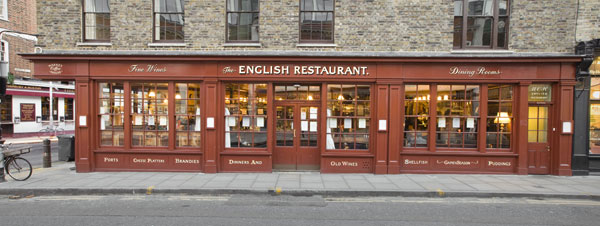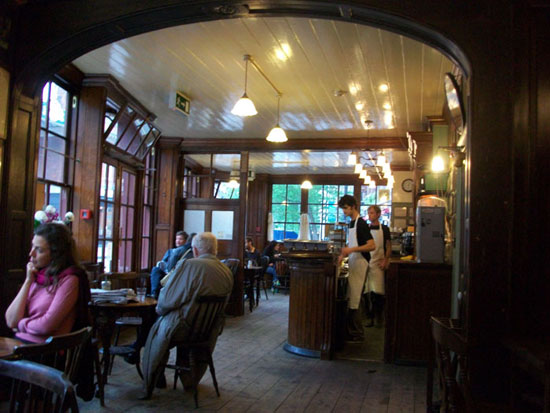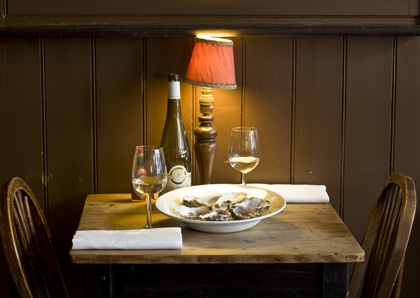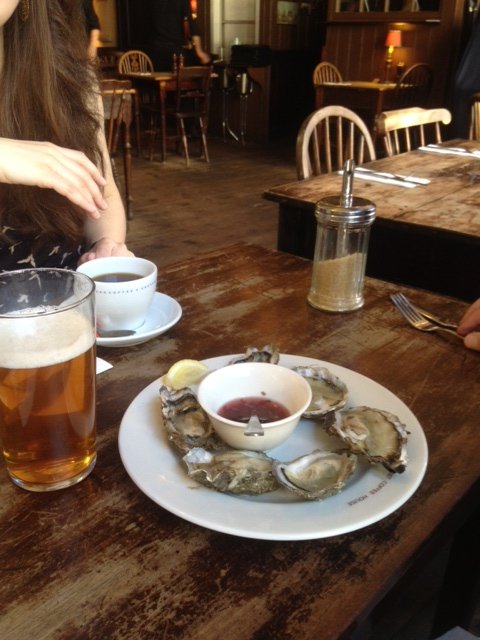Cakes & ale… & oysters in London at the aptly named English Restaurant hard by Spitalfields Market.
Lively Spitalfields supports all manner of food and drink, from clubs famed and obscure to the Bangladeshi bashup of Brick Lane and the outposts of a revived English cuisine. The ancient Spitalfields Market, once source of the produce consumed all over London, has survived the relocation of its original traders and consequent threat to survival. The city has spruced it up and transformed it into a citywide destination for seekers of street fashion, found objects and food.

Hawksmoor opened the first of its reinvented steakhouses in Spitalfields, and the name reflects the neighborhood. Nicholas Hawksmoor’s spooky masterpiece, the striking Christ Church, Spitalfields, closes the vista at the end of Brushfield Street with the most powerful elevation ever attempted in ecclesiastical architecture. Its façade recombines classical elements in such an original manner that contemporaries could not comprehend the design. It was, a critic sneered, “one of the most absurd piles in Europe.” He was a fool; Christ Church now stands within the architectural canon among the greatest buildings ever constructed anywhere.
The design and restaurant consortium Canteen in turn has plunked one of its four branches--modern British design, good traditional British food--into the market building itself. Fergus Henderson could peer through its gateway from St. John Bread & Wine across the noisy Commercial Road and the Jugged Hare nearby gets reverent reviews.
So the English Restaurant has a lot of deep-pocketed competition, but Spitalfields has become a proud community protective of its own and the independent place continues to thrive on the custom of residents like Fiona Atkins, proprietor of the Town House Gallery (eighteenth century cooking manuscripts and prints of Christ Church, among other lovelies) and Jeanette Winterson, who needs no introduction.
The City has drifted over from the west without destroying all of the public houses that provided refreshment for the Spitalfields vegetable traders back in the day; now they get their custom from brokers and hipsters alike. Tracy Emin holds forth for better or worse at the Golden Heart and even the rotten bartenders at Ten Bells beside Christ Church cannot kill the buzz that bounces off its beautiful Victorian tilework.
The English Restaurant started out about a decade ago beside the market on Brushfield Street as, logically, the Market Coffee Shop. They were and are known for their cakes in addition to the coffee. Local people liked it, the owners found ambition, and a few years ago it became the restaurant that it remains. It is what it says, even to the point of selling something once ubiquitous in this multiferous capital but now not so: Oysters.

The look of the place is perfect in an urban English way. It could be older than Rules, and if we know it is not, that does not preclude enjoyment of an eighteenth century idyll; bare floorboards, painted paneling, wooden booths. There are tarnished chandeliers, candles on tables and napkins of cloth.
The English Restaurant feels both raucous and soothing, an atmosphere reinforced by the saucy staff:
‘It says ‘oyster bar’ on the signs. Do you have an oyster bar?’
‘We are an oyster bar and all of ours come from Colchester.’
‘Where is the oyster bar?’
‘You are here.’
‘So you serve oysters but do not have an, actual, oyster bar.’
‘This is a bar (sweep of the hand) and we serve oysters, at ten pounds per six. I think you may find our pricing competitive…. ’
The pricing is more than competitive, and odd as it sounds to anyone caught up in the American oyster Renaissance, we also found it rare for anyone in London to know the actual source of the oysters they served. At any number of more formal and expensive spots than the English Restaurant that we have visited, nobody in the house was quite sure of the precise location where their oysters had lived. The shucker at Randall & Aubin in Soho, for example, was clueless; he referred the Editor to the head line chef, who mumbled something about a shire in Scotland.
In contrast, the Matunuck Oyster Bar can tell its customers the precise part of the salt pond on the coast of Rhode Island where the oysters have been harvested and whether they are wild (rarely) or farmed (with varying degrees of human intervention).
They may know the provenance of their oysters but do not stand on ceremony at the English Restaurant.
‘Are you open on Sunday?’
‘Yes until seven.’
‘So if we booked a table for 6:45, then that would work?’
‘Well on Sundays we do lunch and add a roast too. Relaxing.’
‘So we would be fine?’
‘Hmm… the booking you suggest actually might cheese us off, you know?’
‘Ah linger with lunch as long as you like but then let us go home.’
‘Quite right really, yes.’
‘OK…. ’
Nor do they lie; we were told that reviews of the restaurant had been ‘good, for the most part, some of them, anyway.’
We ordered oysters, drinks arrived at speed (always a relief) but then one of the raconteurs returned; the chef considered half past noon far too early and refused to shuck before one. It turned out, the waiter then confided, that in reality the kitchen found itself in the weeds from two large parties constituting, we were advised, ‘an ‘Old Boy’ luncheon of seventeen along with ‘a hen party; you can cut the sexual tension with a knife.’ We could cancel our drinks if we liked but they beckoned and, though disappointed, demurred. We wondered whether to wheedle some whitebait from the overmatched team but no need. Oysters arrived after all, the product of persistent if deferential persuasion on our behalf and perhaps a sting of remorse on the part of the chef.

None of this is unfriendly; nothing about the place is unfriendly. You can indeed pull up a stool, to eat oysters or anything else they serve, but likely as not the bar will be covered in cakes, another pleasing tint of incongruity.
Food fits the eighteenth century bill, no small compliment from the Editor. There is devilled whitebait and Dover sole, salt beef, savory pudding, oyster fritters too, and breakfast all day; roasts and pies and the English puddings you crave. A long and amiably worn wooden bar supports two engines for pumping cask ales. They are from Redemption, a weak pale ale at 3.8% alcohol and its cleverly labeled Trinity, a weaker 3%. Both beers are fresh and bracing if unobtrusive; the perfect foil for a dozen oysters or two.
They may be from Colchester but these are not the oysters of Roman and Saxon fame, not the round flat fishy natives they prized over any other oyster but rather the less costly ‘rocks’ that were seeded all over the Channel coasts during the twentieth century as blight and pollution threatened to extinguish the natives of France as well as Britain.
The descendants of those rocks, whether Colchester, ‘Belon’ or otherwise, remain ubiquitous at the few oyster bars you will find anymore in the British Isles. Colchester retains a potent cachet for oyster fiends, and judging from ours at the English Restaurant the minerally waters at the mouth of the River Coln have an effect on the flavor of the rock as salubrious as it was (is?) on the native’s.
Even the more fastidious British restaurant critics have failed to distinguish between native and rock. In his review of the English Restaurant in The Times, for example, Giles Coren merely passed over the subject when praising its oysters and a reviewer at www.Squaremeal.co.uk refers only to “nine very excellent Colchester oysters.”
Incidentally Coren writes, if in a rather inelegant way, that he liked the English Restaurant:
“It’s a folksy/elegant paradox of London Ancient and Modern, a lovely, wood-paneled, 17th-century townhouse [a townhouse it is not] which now offers an unselfconscious roster of old English staples…. ”
Back to the rocks, their rise is no bad thing. Pretentious gourmands may claim to relish the flavor of rot tinged with metal that seeps from the native Ostrea edulis, but most people find it unbearable.

The rocks at the English Restaurant were good, actually on final approach to perfect, and much enhanced by a sweetish mignonette. Its foundation was raspberry vinegar, which might have been cloying in theory but in fact could not have been better. Rowan Jacobsen observes with typical perspicacity in The Geography of Oysters that the wrong vinegar overwhelms them, and even prefers citrus--blood orange most--in his mignonette. His point is sound, his mignonette works and the raspberry reminded us of nothing more than that blood.
It all worked equally well with a glass of Champagne (the house, whatever it was, was good) or some pints of Redemption, the name of those doubly fitting because by serving English oysters on the half shell the English Restaurant helps to keep a flagging London tradition alive.
We ought not, however, end on a dutiful note. If asked, our own appraisal of the English Restaurant would be a rave, and we very much want to return.

